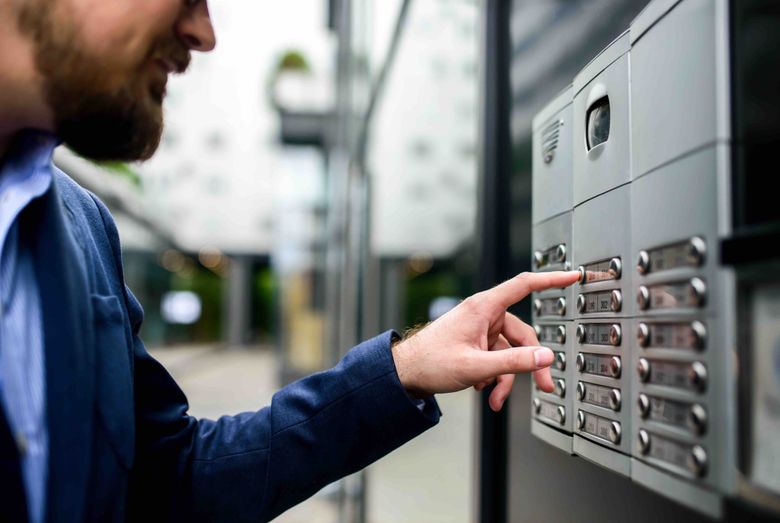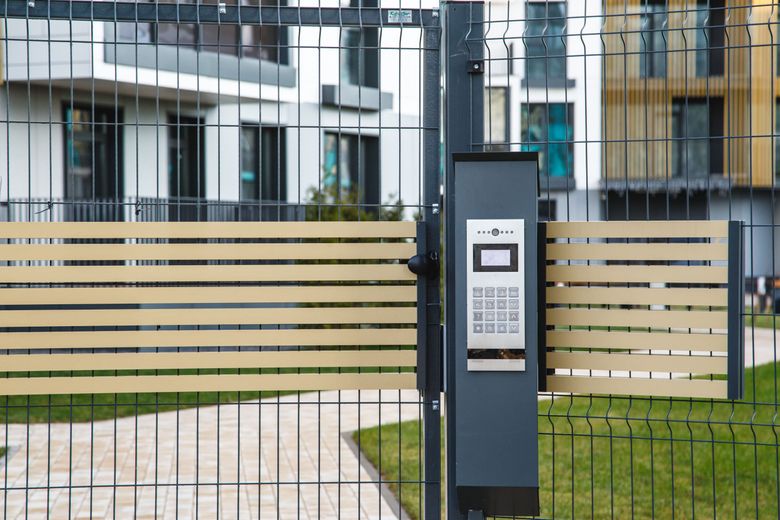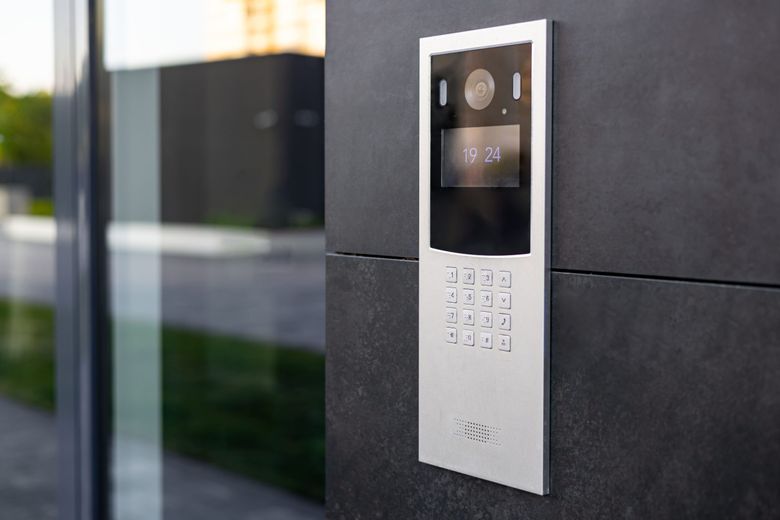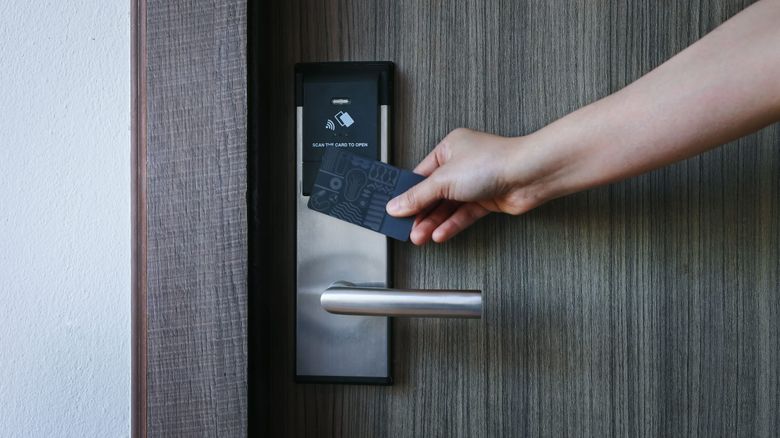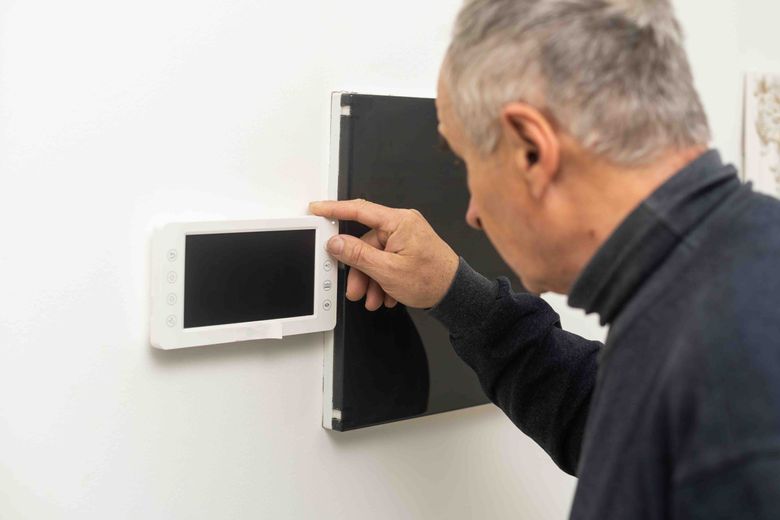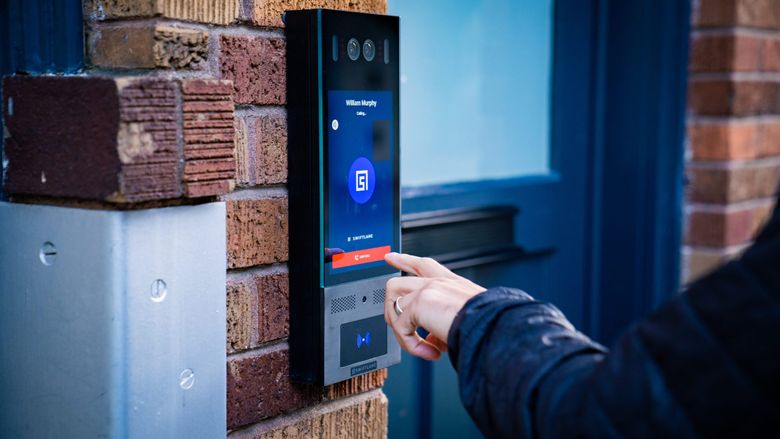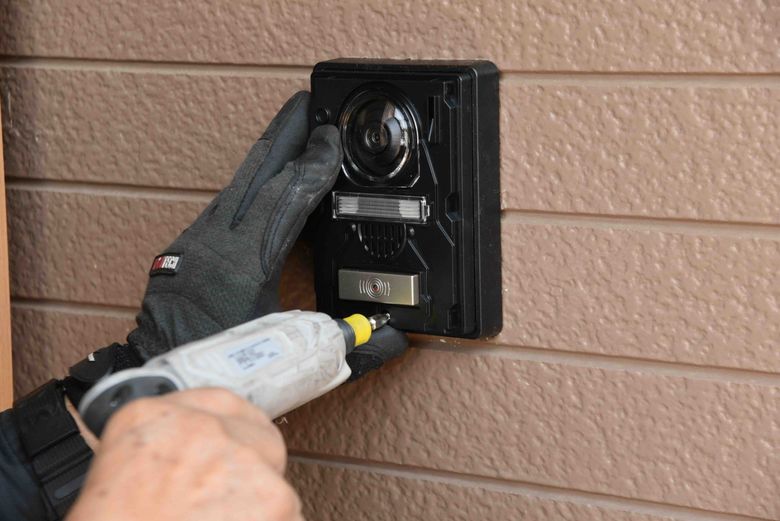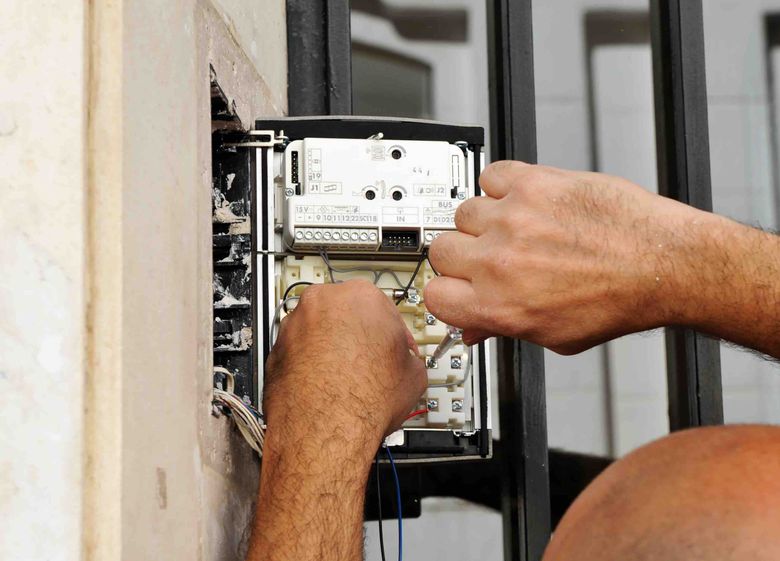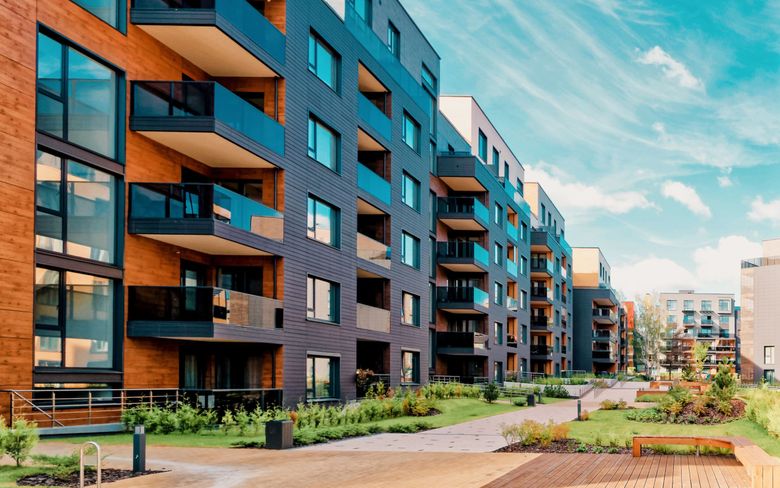In an era defined by rapid technological advancements and the ever-growing need for security and convenience, gate intercom systems have emerged as an indispensable asset for homeowners and businesses alike. As we step into 2023, the landscape of technology continues to evolve at an astonishing pace, and with it, the capabilities and features of gate intercom systems have also progressed in remarkable ways.
Imagine a world where you can effortlessly screen visitors, grant access remotely, and enhance the security of your property with a simple touch or voice command. This is the reality that modern gate intercom systems offer. These sophisticated devices not only provide an additional layer of security but also serve as a seamless bridge between you and the outside world, offering convenience, peace of mind, and unparalleled control over who enters your premises.
In 2023, the technology landscape is a dynamic realm where innovation is not just a buzzword, but a way of life. From artificial intelligence and voice recognition to smart home integration and mobile app connectivity, gate intercom systems have embraced cutting-edge technologies to redefine the user experience. With the pace of change being faster than ever, staying informed about the latest trends and choosing the right gate intercom system can be a daunting task.
That’s where this blog comes in. We understand the importance of making an informed decision when it comes to selecting the right gate intercom system for your specific needs. Our purpose is to provide you with a comprehensive guide to navigating the sea of options available in 2023. Whether you are a homeowner looking to bolster your property’s security or a business owner seeking to streamline access control, we’ve got you covered. We will explore the latest technologies, compare different systems, and provide valuable insights to help you make the best choice for your unique requirements.
Join us on this journey through the world of gate intercom systems in 2023, where technology meets security, and convenience merges with control. It’s time to unlock the possibilities that the future holds for your home or business.
Key Takeaways
- Before selecting a gate intercom system, assess your specific needs. Consider factors like the size of your property, the number of users, and whether you need video capabilities. Understanding your requirements will help you choose a system that suits your situation.
- Gate intercom systems can use various technologies, including wired and wireless options. Consider factors like reliability, ease of installation, and your budget when deciding on the technology that best fits your needs.
- Security should be a top priority when selecting a gate intercom system. Look for features such as video surveillance, access control, and encryption to ensure the safety and privacy of your property.
Suggested Posts
- Choosing The Best Access Door Controller System In 2023
- How To Prevent Package Theft At Your Apartment Building
- How Safe Are Key Lock Boxes Today? An In-Depth Look For 2023
Understanding Gate Intercom Systems
What Is A Gate Intercom System?
A gate intercom system is a communication system commonly used in residential, commercial, or industrial settings to facilitate communication and control access at a gate or entrance. It typically consists of various components and features:
Things to keep in mind:
- Intercom Unit: The core component of the system, the intercom unit allows two-way audio communication between individuals at the gate and those inside the property.
- Gate Access Control: Many gate intercom systems include features to control access, such as the ability to remotely open or close the gate using the intercom unit.
- Camera: Some gate intercoms come with integrated cameras, allowing visual identification of visitors. These can be especially useful for security purposes.
- Keypad or Keyless Entry: Many systems offer keypad or keyless entry options, enabling authorized individuals to enter a code to gain access without the need for physical keys.
- Call Button: A call button on the intercom allows visitors to initiate communication with the property’s occupants.
- Speaker and Microphone: These components ensure clear and audible communication between the visitor and the person inside.
- Video Display: If a camera is included, there is often a video display on the intercom unit or connected to it inside the property.
- Wireless or Wired: Gate intercom systems can be wired or wireless, with wireless options offering easier installation but potentially requiring batteries or regular charging.
- Integration: Some gate intercom systems can be integrated with home automation or security systems, allowing for more advanced control and monitoring.
- Remote Access: Modern gate intercoms often have smartphone apps or remote access capabilities, enabling homeowners or property managers to control access and communicate remotely.
- Visitor Memory: Some systems have the ability to record visitor access logs or capture images of visitors for future reference.
- Access Codes: Authorized users may have unique access codes for security and tracking purposes.
- Intercom Types: There are audio-only intercoms and video intercoms, with varying levels of complexity and features.
- Security: Gate intercom systems enhance security by allowing occupants to verify the identity of visitors before granting access.
- Visitor Convenience: They provide a convenient way for guests or deliveries to communicate with the occupants without physically going to the door.
- Property Types: Gate intercom systems are used in various settings, including residential homes, gated communities, apartment complexes, businesses, and industrial facilities.
- Access Control Management: Some gate intercoms offer management features, allowing administrators to grant or revoke access permissions for different individuals or groups.
- Emergency Communication: In addition to everyday use, gate intercoms can serve as a means of emergency communication for immediate assistance.
- Cost and Features: The cost and features of gate intercom systems can vary widely, depending on the brand, technology, and specific capabilities.
What Is A Wireless Gate Intercom System?
A wireless gate intercom system is a communication system that allows individuals to communicate with visitors at a gate or entrance remotely, without the need for physical wires or cables. These systems are commonly used in residential, commercial, and industrial settings to control access and enhance security.
Things to keep in mind:
Here are the key components and features of a typical wireless gate intercom system:
- Intercom Unit: The intercom unit is installed at the gate or entrance. It includes a microphone and a speaker to facilitate two-way communication between the visitor and the person inside the property.
- Wireless Communication: Instead of traditional wired connections, these systems use wireless technology to transmit audio and sometimes video signals. This can be done via radio frequencies (RF), Wi-Fi, Bluetooth, or cellular networks, depending on the system’s design.
- Power Source: The intercom unit may be powered by batteries, solar panels, or a combination of both. Some systems are designed to be energy-efficient to ensure continuous operation.
- Control Panel: Inside the property, there is typically a control panel or receiver that communicates with the gate intercom unit. This panel allows residents or property owners to answer calls, grant access, and sometimes view video feeds from the gate camera.
- Access Control: Many wireless gate intercom systems are integrated with access control features, such as electronic gate openers or door release mechanisms. This allows authorized individuals to remotely unlock the gate or door for the visitor.
- Video Capability: Some advanced wireless gate intercom systems include a video camera at the gate, providing both audio and visual communication. This adds an extra layer of security by allowing residents to see who is at the gate before granting access.
- Remote Access: Many modern systems offer remote access capabilities through mobile apps or web interfaces. This means that residents can answer calls and control gate access from their smartphones or computers, even when they are not on-site.
- Security and Privacy: Security is a paramount concern for gate intercom systems. Encryption and secure protocols are often used to protect communication, and some systems have built-in features to deter unauthorized access.
How Do Gate Intercom Systems Work?
Gate intercom systems are used to control access to a property or facility by allowing communication between a visitor at the gate and a resident or authorized personnel inside the property.
Gate intercom systems provide a convenient and secure way for residents or authorized individuals to manage access to their property, whether it’s a private home, apartment complex, business, or gated community. They play a crucial role in controlling who enters the premises and ensuring the safety and security of the property and its occupants.
These systems typically consist of several components and work as follows:
- Intercom Unit at the Gate:
- The system starts with an intercom unit installed at the gate or entrance point. This unit includes a microphone, speaker, and often a camera for video communication.
- When a visitor arrives at the gate, they can press a button or use an access code to initiate communication.
- Indoor Intercom Station:
- Inside the property, there is usually an indoor intercom station or device connected to the outdoor intercom unit.
- This indoor station often includes a speaker, microphone, and a display screen if it’s a video intercom system.
- When a visitor initiates communication, the indoor station receives the call and allows the resident or authorized person to communicate with the visitor.
- Communication:
- Communication between the visitor and the resident/authorized person is two-way. They can talk to each other using the microphone and speaker on their respective units.
- In video intercom systems, the resident can also see the visitor through the camera on the outdoor intercom unit.
- Access Control:
- In addition to communication, gate intercom systems often have access control features. This means the resident can remotely grant or deny access to the visitor.
- Access control options may include remotely opening the gate or door, activating a gate release mechanism, or simply denying access if the visitor is not authorized.
- Power and Connectivity:
- Gate intercom systems require a power source, which can be from a wired electrical connection or, in some cases, from batteries or solar panels.
- They also require connectivity, which can be wired (e.g., Ethernet or phone line) or wireless (e.g., Wi-Fi or cellular networks) depending on the specific system.
- Additional Features:
- Many modern gate intercom systems come with additional features like call forwarding to mobile devices, integration with home automation systems, and the ability to record video or audio conversations for security purposes.
- Integration:
- Gate intercom systems can be integrated with other security systems, such as surveillance cameras, access control systems, and alarms, to enhance overall security and control.
Why Should You Install A Wireless Gate Intercom System?
Installing a gate intercom system can offer several benefits, making it a valuable addition to your property. Here are some reasons why you should consider installing a gate intercom system:
- Enhanced Security:
- Control Access: A gate intercom system allows you to control who enters your property. You can communicate with visitors before granting them access, reducing the risk of unauthorized entry.
- Deterrence: Visible intercom systems can deter potential intruders or unwanted visitors from attempting to enter your property.
- Convenience:
- Remote Access: Modern gate intercom systems often come with remote access features, enabling you to answer calls and grant access from your smartphone, tablet, or computer, even when you’re not at home.
- Package Delivery: You can provide delivery personnel with access instructions, ensuring your packages are securely delivered inside your gate.
- Improved Communication:
- Visitor Verification: You can verify the identity of visitors before allowing them access, which can be particularly important for residential communities or businesses.
- Two-Way Communication: Intercom systems facilitate clear two-way communication, allowing you to converse with visitors without having to physically approach the gate.
- Increased Privacy:
- Control Over Unwanted Visitors: A gate intercom system lets you deny access to unwanted solicitors, salespeople, or anyone else you wish to keep away from your property.
- Record Keeping:
- Documentation: Many gate intercom systems have recording capabilities, allowing you to document all interactions at the gate, which can be useful for security and record-keeping purposes.
- Property Value:
- Increased Property Value: Installing a gate intercom system can enhance the perceived and actual value of your property, making it more attractive to potential buyers or renters.
- Access Control:
- Multiple Entry Codes: Some systems allow you to assign unique entry codes to different individuals, making it easier to manage access for residents, guests, and service providers.
- Access Logs: Gate intercom systems often maintain access logs, helping you keep track of who enters and exits your property.
- Peace of Mind:
- Safety: Knowing who is at your gate and being able to communicate with them before granting access can provide peace of mind, especially in high-crime areas or remote locations.
- Compliance:
- Community or Building Regulations: In some gated communities or multi-unit buildings, the installation of a gate intercom system may be required to comply with association rules or building codes.
- Visitor Experience:
- Welcoming Guests: A gate intercom system allows you to welcome guests and provide them with instructions on how to reach your location easily.
Why Should You Install A Wireless Gate Intercom System?
- The price range for a wireless gate intercom can range from $1,000 to approximately $7,000.
- This cost is not fixed and can vary based on several factors, primarily determined by the number of substations you intend to set up.
- To cut down on expenses, it’s advisable to seek out a wireless gate intercom system that utilizes smartphones as its substations.
- By doing so, you can avoid the need to purchase and install extra hardware.
- Furthermore, it’s essential to take into account the expenses associated with essential components.
- If you do not already have one in place, you will have to install an electric locking system alongside the intercom.
- Additionally, your intercom system may come with service fees for supporting features such as video capabilities, mobile applications, and integrations.
- Therefore, obtaining a price quote is crucial to gain a comprehensive understanding of the total cost involved.
Types Of Gate Intercom Systems
Gate intercom systems are essential for enhancing security and convenience at entrances to homes, businesses, and other properties. They come in various types, each with its own set of features and advantages. In this detailed explanation, we will explore the different types of gate intercom systems, namely audio intercom systems, video intercom systems, wireless vs. wired intercom systems, and smart intercom systems.
Audio Intercom Systems
Definition and Functionality
Audio intercom systems are the most basic type of gate intercom. They allow for voice communication between the person at the gate and the person inside the property. Typically, they consist of a gate station with a microphone and speaker and an indoor station that allows the occupant to hear and respond to the visitor. Communication is usually one-way at a time, meaning that either the visitor or the occupant can talk while the other listens.
Advantages and Disadvantages
Advantages:
- Simplicity: Audio intercoms are straightforward to use and install.
- Cost-effective: They are often more affordable compared to video intercom systems.
- Privacy: Audio intercoms offer a higher level of privacy since there is no visual component.
Disadvantages:
- Limited Information: Lack of video means occupants cannot see who is at the gate, which might be a security concern.
- Limited Interaction: Communication is limited to voice, which may not be sufficient in some situations.
Video Intercom Systems
Definition and Functionality
Video intercom systems, as the name suggests, include a visual component in addition to audio communication. These systems typically consist of a gate station with a camera, microphone, and speaker, along with an indoor station with a screen and intercom features. Users can see and talk to the visitor at the gate, making it a more comprehensive solution.
Advantages and Disadvantages
Advantages:
- Enhanced Security: Video intercoms provide a clear view of the visitor, allowing occupants to verify their identity.
- Increased Convenience: Users can visually confirm guests without leaving their location.
- Deterrence: The presence of a camera can deter potential intruders.
Disadvantages:
- Higher Cost: Video intercom systems tend to be more expensive than audio-only systems.
- Installation Complexity: They may require more wiring and installation effort.
Difference Between Wireless vs. Wired Intercom Systems
| Aspect | Wireless Intercom System | Wired Intercom System |
| Installation | Typically easier and faster to install as there are no wires to run. | Requires running cables and wiring between units, which can be labor-intensive. |
| Mobility | Offers greater mobility and flexibility since there are no physical connections. | Limited mobility as it relies on wired connections between units. |
| Range | Limited by the wireless signal range, which can vary depending on the system. | Generally offers longer and more reliable communication ranges, limited only by the length of the wires. |
| Reliability | Susceptible to interference and signal disruptions, especially in crowded wireless environments. | Generally more reliable as it is not prone to wireless interference. |
| Maintenance | Requires less maintenance, but may need battery replacements or recharging for wireless units. | Typically requires less frequent maintenance, primarily focused on checking and repairing cables. |
| Scalability | Easier to expand by adding additional wireless units as needed. | Expanding the system can be more complex as it involves running new cables. |
| Cost | Usually more expensive due to wireless technology and battery-powered components. | Often less expensive initially but may incur higher installation costs. |
| Audio Quality | Audio quality can be affected by wireless interference, resulting in occasional disruptions. | Generally provides stable and consistent audio quality. |
| Security | May be more susceptible to hacking or unauthorized access if not properly secured. | Generally considered more secure as it is not vulnerable to wireless eavesdropping. |
| Aesthetics | Tends to be visually cleaner since there are no visible wires. | May have visible wires, which can affect the aesthetics of the installation. |
Why is a Wireless Intercom Better than a Wired Intercom System?
Whether a wireless intercom is better than a wired one depends on specific needs and preferences. Wireless intercoms are preferable when:
- Ease of installation and mobility is crucial.
- Extensive wiring is impractical or costly.
- The property layout necessitates flexibility in station placement.
- The risk of interference is minimal or manageable.
Smart Intercom Systems
Integration with Home Automation
Smart intercom systems are designed to integrate with home automation and smart security systems. They can be controlled remotely through smartphones or tablets, allowing users to answer the gate from anywhere and even grant access remotely.
Benefits and Features
- Remote Access: Users can answer the gate from their smartphones, enhancing security and convenience.
- Visitor Logs: Smart intercoms often maintain logs of visitor interactions.
- Integration: They can integrate with other smart devices like security cameras, smart locks, and lighting systems.
- Video Recording: Some models offer video recording of gate interactions for added security.
Use Cases
Dual-Home Intercom Gate System
The dual-home intercom gate system represents a groundbreaking innovation tailored to establish a seamless connection between two distinct households that share a common entrance. This technological marvel serves to facilitate effortless communication and access control for both properties. For homeowners who either share an entry point or aspire to maintain close-knit ties with their neighbors, this system presents a multitude of benefits.
Advantages of the Dual-Home Intercom Gate System
- Heightened Security: By interlinking two homes through a shared gate intercom network, both property owners gain the ability to monitor and regulate access to their domains, thereby bolstering security and minimizing the risk of unauthorized intrusions.
- Enhanced Communication: The dual-home intercom gate system establishes a streamlined avenue for communication between the connected households. Neighbors can swiftly get in touch with each other during emergencies or for general coordination without the necessity of telephone calls or physically traversing to the other residence.
- Collaborative Vigilance: Through the shared gate intercom mechanism, both homeowners can actively partake in the task of overseeing and managing access, ensuring that at least one of them remains available to respond to visitor requests or urgent situations.
- Cost Efficiency: The installation of a shared gate intercom system for two homes proves to be a more economical alternative compared to investing in separate setups for each property. This arrangement allows both homeowners to equitably distribute the expenses related to installation, maintenance, and potential upgrades.
Selecting the Optimal System:
When contemplating the acquisition of an intercom system designed for dual-home usage, it is crucial to factor in elements like:
- Integration Capabilities: Opt for a system that seamlessly integrates with other security apparatuses in both residences, such as CCTV cameras, alarm systems, and access control systems. SIP-based gate intercom systems are especially adept at this, as they offer effortless compatibility with other IP-based devices.
- Range and Signal Strength: Given that the intercom system must span two separate residences, ensure that it boasts ample range and signal strength to uphold clear communication and high-quality video transmission between the properties.
- User Management: Opt for a system that simplifies user management, access codes, and permissions for both homeowners. This empowers each homeowner to exercise control over who can access their property while managing the shared gate collectively.
- Scalability: Contemplate a gate intercom system with the potential for future expansion or enhancement, such as accommodating more users, devices, or integrating with additional security systems.
Multi-Tenant Gate Intercom System
A multi-dwelling complex intercom system has been purposefully designed for residential and commercial properties that house multiple units, including apartment complexes, condominiums, and office buildings. This versatile system facilitates efficient visitor management, robust access control, and enhanced communication among tenants, property managers, and security personnel.
Advantages of a Multi-Tenant Gate Intercom System:
- Streamlined Visitor Management: The multi-dwelling complex intercom system empowers property managers or security personnel to oversee visitor access efficiently, screening and authorizing entry remotely, thereby reducing the need for manual interventions at the entrance.
- Augmented Security: With this system in place, property managers gain the ability to vigilantly monitor and control access to the entire complex, ensuring that only authorized individuals gain entry. This serves as a deterrent against unauthorized access and potential security breaches.
- Elevated Tenant Convenience: Tenants can engage in seamless communication with visitors and grant access remotely, eliminating the need to physically visit the entrance or gate. This not only enhances convenience but also bolsters security measures.
- Scalability and Adaptability: Contemporary multi-dwelling complex intercom systems can be tailored and expanded to accommodate evolving property requirements, such as the inclusion of additional units, integration with other security systems, or updates to access codes and permissions.
Selecting the Ideal System
In the process of choosing a multi-dwelling complex intercom system, consider the following aspects:
- Integration Capabilities: Prioritize a system that effortlessly harmonizes with other security devices and systems within the property, such as CCTV cameras, alarm systems, and access control systems. SIP-based gate intercom systems excel in seamless integration with other IP-based devices.
- User Management: Opt for a system that simplifies tenant management, access codes, and permissions. This empowers property managers to efficiently uphold security and regulate access to the property.
- Video and Audio Quality: Ensure that the system offers high-definition video and crisp audio quality, enabling precise identification and uninterrupted communication between tenants and visitors.
- Advanced Keyless Entry Features: Seek out a system that provides advanced keyless entry options, such as keypads, NFC, or BLE technology, for heightened convenience and security.
Factors To Consider When Choosing A Gate Intercom System
Choosing the right gate intercom system is a crucial decision for enhancing security and communication at your property. To make an informed choice, it’s essential to consider several factors. In this detailed guide, we will elaborate on each point to help you make an informed decision:
Location and Purpose
- Residential vs. Commercial: The first consideration is whether the intercom system is intended for residential or commercial use. Residential systems typically have simpler features and are more budget-friendly, while commercial systems need to handle higher traffic and may require advanced features like access logs and multiple communication channels.
- Indoor vs. Outdoor: Determine where the intercom system will be installed. Outdoor units should be weatherproof and durable to withstand various weather conditions, while indoor units can be more lightweight and may focus on audio quality.
Budget
- Cost Breakdown: Create a detailed budget that includes not only the initial purchase cost but also installation, ongoing maintenance, and any subscription fees for added services like cloud storage. Ensure that your budget accounts for any additional components you may need, such as cameras or access control devices.
- Long-term Savings: Consider the long-term cost-effectiveness of the system. While cheaper options may save money upfront, they may lack durability or advanced features. High-quality systems might have a higher initial cost but can offer long-term savings through reliability and fewer maintenance issues.
Connectivity Options
- Internet Connectivity: Determine if you want your intercom system to be connected to the internet. Internet connectivity enables remote access and control, allowing you to answer calls or grant access from anywhere. However, this also introduces potential cybersecurity concerns.
- Cellular vs. Wi-Fi: If you choose internet connectivity, decide between cellular or Wi-Fi connections. Cellular connections are often more reliable but may come with monthly data fees. Wi-Fi connections rely on your existing network, so ensure your network can handle the additional load.
Security Features
- Access Control: Evaluate the access control features of the system. Look for options like PIN codes, biometric authentication, or RFID cards to enhance security. Advanced systems may even integrate with your existing security infrastructure.
- Video Recording and Storage: Video capabilities are essential for visual verification. Consider whether you need real-time video streaming, video recording, and how long you want to store the footage. Cloud storage can be convenient but may come with subscription costs.
- Encryption and Authentication: Ensure that the system uses encryption to secure communication and authentication methods to prevent unauthorized access. This is crucial for protecting your data and property.
Ease of Installation
- DIY vs. Professional Installation: Determine if you have the technical skills and tools to install the system yourself or if you should hire a professional. Complex systems or those integrated with other security components may require professional installation for optimal performance.
- Compatibility with Existing Systems: If you have an existing security or access control system, ensure that the new intercom system is compatible. Compatibility can save you money and streamline your security infrastructure.
Brand and Reputation
- Researching Reputable Manufacturers: Look for well-established manufacturers known for quality and reliability. Check if they have a track record of providing updates and support for their products.
- Reading Reviews and Seeking Recommendations: Read customer reviews and seek recommendations from friends, family, or security professionals who have experience with the specific intercom system you’re considering. Real-world feedback can be invaluable.
Maintenance and Support
- Warranty and Support Services: Investigate the warranty offered by the manufacturer. A longer warranty period indicates the manufacturer’s confidence in their product. Additionally, check if they offer customer support and how responsive they are to inquiries or issues.
- Replacement Parts Availability: Over time, components may wear out or become outdated. Ensure that replacement parts for your chosen intercom system are readily available to avoid compatibility issues and lengthy downtimes.
Popular Gate Intercom System Brands In 2023
Swiftlane
Overview:
Swiftlane is a dynamic cloud-based access control system that integrates mobile unlock, face recognition, video intercom and visitor management for a secure, touchless access control experience. The SwiftReader is a compact solution used to secure any building, from small office spaces to high-rise residential buildings.
Most notably, Swiftlane was awarded the best new access control system by the Security Industry Association in 2020.
In 2021, Swiftlane was recognized several times in the Architizer A+ Product Awards.
Swiftlane Features:
- Touchless Access Control: Swiftlane provides touchless entry to doors using face recognition and mobile access technology. A person can just walk up the door, look at the reader and the door unlocks.
- Remote Management: Swiftlane’s cloud based access control is built to be managed from anywhere. The system is built to provide instant ability to add or revoke access, and connect with other systems like HR, employee identity and login providers, to automate the process of adding or removing users. This allows higher security and leaked access to people.
- Integrated Video Intercom: Most access control systems require installing and managing a separate intercom system for handling guests, which results in higher installation, training and operational costs. Swiftlane, however, has a built-in video intercom system for secure visitor management.
- Cloud-Based Management: Instead of operating over on-premise software, Swiftlane operates completely and securely from the cloud. The cloud-based dashboard and admin management provides the highest discretion for the end user along with the highest level of security.
Swiftlane
Overview:
Swiftlane is a dynamic cloud-based access control system that integrates mobile unlock, face recognition, video intercom and visitor management for a secure, touchless access control experience. The SwiftReader is a compact solution used to secure any building, from small office spaces to high-rise residential buildings.
Most notably, Swiftlane was awarded the best new access control system by the Security Industry Association in 2020.
In 2021, Swiftlane was recognized several times in the Architizer A+ Product Awards.
Swiftlane Features:
- Touchless Access Control: Swiftlane provides touchless entry to doors using face recognition and mobile access technology. A person can just walk up the door, look at the reader and the door unlocks.
- Remote Management: Swiftlane’s cloud based access control is built to be managed from anywhere. The system is built to provide instant ability to add or revoke access, and connect with other systems like HR, employee identity and login providers, to automate the process of adding or removing users. This allows higher security and leaked access to people.
- Integrated Video Intercom: Most access control systems require installing and managing a separate intercom system for handling guests, which results in higher installation, training and operational costs. Swiftlane, however, has a built-in video intercom system for secure visitor management.
ADT Access Control
Overview
ADT is best-known for home security solutions, but their access control system, which is marketed by ADT Commercial, can fulfill basic security needs for small scale operations.
ADT Access Control Features
- Sensor-based central station monitoring
- Manned alarm monitoring and emergency response services
- Remote capabilities include lock/unlock, video monitoring, password management and system arm/disarm.
The Swiftlane Difference
Swiftlane’s mobile and biometric access credentials surpass the standard security parameters by operating from the cloud. Swiftlane Access Control plays a preventative role in security, as opposed to a reactive approach based in emergency response services. Additionally, our cloud-based platform allows admins to easily manage users from the dashboard instead of having to navigate through the vendor.
S2 Access Control
Overview
S2 is among the pioneers of web-based physical access control and security systems. Today, Lenel S2 positions itself as a unified security platform comprising access control, video surveillance, video security, and more.
S2 Access Control Features
- Unified security solution through S2 NetBox
- Supports legacy access control methods and many different integrations
- Video monitoring
- S2 Magic Monitor is a unified display interface that joins access control, video surveillance, live internet feeds, security events and alarms, credentials and access level management
- Mobile video management
The Swiftlane Difference
Swiftlane is a cloud-based access control system that operates without the need for an on-site server, which requires heavy operational overhead. The cloud-based system allows you to manage users through identity providers without integration, as well as perform functions remotely.
Installation and Setup
Gate intercom systems have become an indispensable part of modern security solutions. Whether it’s for residential or commercial use, these systems provide convenience and enhance security by allowing you to communicate with visitors and grant access remotely. However, to fully enjoy the benefits of your gate intercom system, it’s crucial to ensure proper installation and setup. In this comprehensive guide, we’ll explore the installation and setup process, including DIY installation, professional installation, and troubleshooting common issues.
DIY Installation Guide
Step-By-Step Instructions
Before you embark on a DIY installation journey, it’s essential to understand the specific steps involved:
- Choose the Right Location: Begin by selecting an appropriate location for your gate intercom unit. Ideally, it should be easily accessible and offer a clear view of the gate entrance.
- Mount the Intercom Unit: Use the provided mounting hardware to securely attach the intercom unit to a sturdy surface. Ensure that it’s at a comfortable height for communication.
- Wiring: Carefully route the wiring from the intercom unit to the power source and any other necessary components. Follow the manufacturer’s wiring diagram to make the connections correctly.
- Power Supply: Connect the intercom unit to a power source, typically using low-voltage wiring. Ensure the power supply is stable and reliable.
- Connect to Wi-Fi: If your gate intercom system supports Wi-Fi connectivity, configure it to connect to your home network. Follow the instructions provided in the user manual.
- Test the System: Before finalizing the installation, test the system to ensure that the intercom unit communicates with the main control panel and that you can receive calls and control gate access.
- Adjust Settings: Configure any additional settings, such as call forwarding, access control, and notifications, to suit your preferences.
Tools And Materials Needed
To complete the DIY installation successfully, you’ll need the following tools and materials:
- Intercom unit and all associated components
- Mounting hardware (screws, brackets, anchors)
- Wiring and cable connectors
- Power supply and voltage converter (if required)
- Screwdriver, drill, and appropriate drill bits
- Wire stripper and cutter
- Level and measuring tape
- Smartphone or computer for configuring Wi-Fi settings
Professional Installation
While DIY installation can be a cost-effective option for tech-savvy individuals, there are situations where it’s best to seek professional help.
When To Consider Professional Help
You should consider professional installation in the following scenarios:
- Complex Systems: If your gate intercom system is part of a more extensive security setup, involving multiple cameras, alarms, and access control systems, it’s advisable to hire a professional installer who can integrate all these components seamlessly.
- Lack of Technical Knowledge: If you lack the technical expertise or confidence to perform electrical wiring, configure network settings, or troubleshoot potential issues, professional installers can ensure a smooth and error-free setup.
- Custom Requirements: When you have specific custom requirements or a unique gate entrance layout, professionals can design a tailored solution to meet your needs.
Choosing A Qualified Installer
When selecting a professional installer, consider the following factors:
- Experience: Look for installers with a proven track record in gate intercom system installation. Ask for references and check their portfolio of completed projects.
- Licensing and Certification: Ensure that the installer is licensed and certified in accordance with local regulations and industry standards.
- Warranty and Support: Inquire about warranties and ongoing support services offered by the installer. This ensures that you have assistance in case of any issues post-installation.
- Cost: Request quotes from multiple installers and compare their pricing. Be cautious of unusually low prices, as they may indicate subpar service or components.
Troubleshooting Common Installation Issues
Even with a DIY installation or professional help, you may encounter some common issues during the setup process. Here’s how to troubleshoot them:
Connectivity Problems
Possible Causes: Weak Wi-Fi signal, incorrect network settings, or interference.
Troubleshooting Steps:
- Ensure the intercom unit is within the range of your Wi-Fi network.
- Verify that the network SSID and password are entered correctly.
- Check for and eliminate sources of interference, such as other electronic devices or metal barriers.
Power Supply Issues
Possible Causes: Incorrect voltage, loose wiring connections, or power source problems.
Troubleshooting Steps:
- Double-check the power supply voltage matches the intercom unit’s requirements.
- Inspect wiring connections for loose or damaged wires.
- Test the power source to ensure it’s delivering the required voltage consistently.
Interference And Signal Loss
Possible Causes: Obstacles or interference between the intercom unit and control panel, or environmental factors like heavy rain or snow.
Troubleshooting Steps:
- Reposition the intercom unit for a clearer line of sight to the control panel.
- Check for any physical obstructions that might block the signal.
- If interference is due to weather conditions, consider installing protective covers or enclosures.
Tips For Maintaining Your Gate Intercom System
Maintaining your gate intercom system is crucial to ensure its longevity, functionality, and security. A well-maintained system not only provides convenience but also enhances security at your property entrance. In this comprehensive guide, we will delve into the various aspects of maintaining your gate intercom system, including cleaning and maintenance schedules, software updates and security patches, monitoring and testing, and emergency preparedness.
Cleaning and Maintenance Schedule
Regular Cleaning
- Start by visually inspecting your gate intercom system for dirt, dust, and debris.
- Clean the exterior components, including the camera lens, microphone, and keypad, using a soft, lint-free cloth and mild soapy water.
- Avoid using abrasive materials or harsh chemicals, as they can damage the system’s surfaces.
Inspect Wiring and Connections
- Periodically check the wiring and connections between the intercom unit and the control panel.
- Ensure that there are no loose or exposed wires.
- Inspect the power supply and battery connections to ensure they are secure.
Weatherproofing
- If your gate intercom system is exposed to the elements, inspect the weatherproofing seals and gaskets.
- Replace any damaged or deteriorated seals to prevent water and dust ingress.
Battery Maintenance
- If your system uses batteries, monitor their condition and replace them as needed, following the manufacturer’s recommendations.
- Clean the battery terminals to prevent corrosion.
Software Updates and Security Patches
Firmware Updates
- Regularly check for firmware updates provided by the manufacturer.
- These updates often include bug fixes, performance enhancements, and security improvements.
- Follow the manufacturer’s instructions to apply updates correctly.
Security Patches
- Stay informed about security vulnerabilities that may affect your gate intercom system.
- The manufacturer may release patches to address these vulnerabilities.
- Ensure that you apply security patches promptly to protect against potential breaches.
Monitoring and Testing
Regular Functionality Tests
- Conduct routine tests of the intercom system to ensure all components are functioning correctly.
- This includes testing the camera, microphone, speaker, keypad, and access control features.
- Verify that the intercom communicates effectively with the control unit.
Network Connectivity
- Monitor the network connectivity of your gate intercom system.
- If it’s connected to your home network, ensure a stable and secure connection.
- Check for any unauthorized devices connected to the network.
Access Logs
- Review access logs regularly to identify any suspicious or unauthorized access attempts.
- This helps maintain security and provides a record of who has used the system.
Emergency Preparedness
Backup Power
- Ensure your gate intercom system has a backup power source, such as a battery or generator, to operate during power outages.
- Test the backup power source periodically to ensure it functions as intended.
Emergency Codes and Procedures
- Establish emergency access codes and procedures in case of system malfunctions or emergencies.
- Share these codes and procedures with authorized users and update them as needed.
Service Contracts
- Consider a service contract with a professional security provider for regular maintenance and emergency support.
- Have contact information readily available for quick access in case of technical issues.
Future Trends in Gate Intercom Systems
Gate intercom systems have evolved significantly over the years, adapting to the ever-changing technological landscape and the growing demands for convenience, security, and energy efficiency. In this comprehensive overview, we will delve into the future trends shaping gate intercom systems:
Emerging Technologies
Artificial Intelligence (AI)
- Emerging technologies, especially AI, are set to play a pivotal role in the evolution of gate intercom systems.
- AI can enhance user experience and security.
- For instance, AI-powered voice recognition and natural language processing can make interactions with the intercom more intuitive and user-friendly.
- Facial recognition technology can be integrated into gate intercoms to allow for secure access, recognizing authorized individuals automatically.
- This can enhance security by preventing unauthorized entries.
Facial Recognition
- Facial recognition technology has the potential to revolutionize gate intercoms.
- These systems can identify and verify individuals, allowing for seamless and secure access control.
- Facial recognition can be used in combination with other security measures like PINs or mobile apps for multi-factor authentication, ensuring a high level of security.
Machine Learning Algorithms
- Machine learning algorithms can continuously learn and adapt to the user’s preferences and behavior, making gate intercom systems more responsive and user-centric.
- They can anticipate user needs, like automatically opening the gate when a recognized user approaches.
Sustainability and Energy Efficiency
Solar-Powered Systems
- Sustainability is a growing concern, and gate intercoms are not exempt from this trend.
- Future gate intercoms may incorporate solar panels to reduce their carbon footprint.
- These panels can provide the necessary energy to power the intercom system, including cameras and sensors, making them more energy-efficient and environmentally friendly.
Energy-Efficient Components
- Gate intercom systems will likely utilize energy-efficient components to reduce power consumption.
- LED lighting, low-power processors, and energy-efficient communication protocols will be integrated to extend the life of batteries and reduce overall energy consumption.
Integration with Smart Homes and IoT
Seamless Integration with Smart Homes
- Future gate intercoms will become an integral part of smart home ecosystems.
- They will seamlessly integrate with other smart devices, such as door locks, surveillance cameras, and home automation systems.
- Users can control their gate intercoms through voice commands or smartphone apps, enhancing convenience and security.
IoT Connectivity
- Internet of Things (IoT) connectivity will allow gate intercoms to communicate with a wider network of devices and systems.
- For example, the intercom can send alerts to homeowners’ smartphones when a visitor arrives or when an unauthorized entry attempt is detected.
- This integration enhances security and enables homeowners to respond quickly to potential threats.
Enhanced Security Features
Advanced Encryption and Authentication
- To counter cybersecurity threats, future gate intercoms will employ advanced encryption methods to protect data transmission.
- Additionally, robust authentication mechanisms will ensure that only authorized individuals can access and control the intercom system.
Remote Monitoring and Access Control
- Enhanced security features will enable homeowners to remotely monitor their gate intercoms and control access.
- They can view live video feeds, review access logs, and grant or deny access from anywhere with an internet connection, adding an extra layer of security and convenience.
Let’s Wrap Up
As we wrap up, it’s essential to reiterate why choosing the right gate intercom system matters. Your security, convenience, and peace of mind are at stake. A well-chosen system can enhance the security of your property, streamline access for authorized personnel, and even add value to your home or business.
In 2023, the world of gate intercom systems continues to advance at a rapid pace, and making an informed decision is more critical than ever. As technology evolves, so do the capabilities and features of these systems. We encourage you to stay up-to-date with the latest developments, consult with experts, and thoroughly research your options before making a choice.
In the end, remember that the right gate intercom system is not just a device; it’s an investment in your security and convenience. So, as you embark on your journey to find the perfect system for your needs, we hope this guide has provided you with valuable insights and considerations to make the best decision possible. May your choice in 2023 lead to a safer, more secure, and more connected future for your property.
FAQs
What should I consider when choosing a gate intercom system in 2023?
When selecting a gate intercom system in 2023, focus on key features like video quality, remote access via mobile apps, compatibility with smart home systems, two-way communication, and durability. Look for systems that offer clear video feeds, the ability to answer calls and grant access remotely, and integration with your existing smart home devices for added convenience.
Should I opt for a wired or wireless gate intercom system in 2023?
The choice between wired and wireless gate intercom systems in 2023 largely depends on your specific needs. Wired systems are known for their reliability and stable connections, making them a good choice for permanent installations. On the other hand, wireless systems offer flexibility and easier installation, making them suitable for locations where wiring may be challenging. Assess your requirements and infrastructure before making a decision.
What steps can I take to secure my gate intercom system in 2023?
To enhance the security of your gate intercom system in 2023, consider using strong, unique passwords and enabling two-factor authentication for remote access. Regularly update firmware to patch vulnerabilities, limit access to authorized users, and install security cameras to monitor the area around your gate. These measures will help protect your system from potential threats.
Can I connect my gate intercom system to other smart home devices like door locks or lights?
Yes, many gate intercom systems in 2023 offer integration with other smart home devices. Look for systems that support popular protocols like Z-Wave or Zigbee, as this will allow you to connect your intercom system to door locks, lights, and even voice assistants like Amazon Alexa or Google Assistant. This integration enhances your overall home automation experience.
What should I do if my gate intercom system experiences technical problems in 2023?
If you encounter technical issues with your gate intercom system in 2023, start by checking the power source and connections. Ensure that your internet connection is stable. If problems persist, refer to the user manual for troubleshooting steps. If the issue remains unresolved, contact the manufacturer’s customer support for assistance. Regular maintenance and timely troubleshooting can help keep your system running smoothly.

